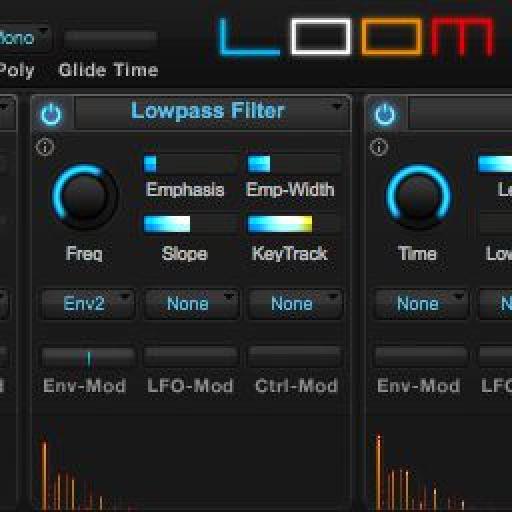Air Music Technology are known for slick virtual effects and instruments that look as good as they sound. Their latest product, Loom, takes a novel approach to the elusive art of additive synthesis.
Rather than start with a full-bodied oscillator and modify it with filters and envelopes that subtract from the original sound, additive synthesis builds timbers up by layering and merging together tens or hundreds of separate sine waves – resulting in some truly unique and richly nuanced sounds. Getting a handle on this style of synthesis can be tricky even for those well versed in other forms of sound science, but Loom makes it easy: with this exquisitely implemented soft-synth, you'll be generating lush and dynamic sounds in no time at all.
Fabric and Thread
Before getting into Loom's genius time-saving tools, let's take a look under the hood. Of Loom's two main views, Edit mode is where you can build your sinusoidal sounds up from scratch.
Starting with the default Spectral Distortion unit in the upper left of the Edit mode, we begin by choosing from seventeen spectral distortion types, which determine how our sine wave partials are spread out, and, if we want, modulated. From there, we have up to ten sequential modules, each of which can be selected from eight “basic” modules, eight filter modules, six effect modules, two rhythmic modules, two time modules, six “tools”, or a selectable waveform. Each of these shapes our partials as they pass through, and each module can be individually modulated by one of four envelopes, one of three sync-able LFOs, and a velocity or key input; these modulators can be accessed and edited along the bottom of the Edit view.
Finally, our partials pass into the FX unit, which contains distortion, modulation, delay and reverb – and then into our master width and volume, with a built-in limiter which comes in very handy for the sudden amplitude jumps that tend to occur when experimenting with additive synthesis. Each module can easily be activated and deactivated to determine its relevance to the resulting tone. Simply using trial and error to explore all the different module types, I was able to create a wide spectrum of wild and usable tones – but Loom's greatest strength perhaps lies in its intuitive Morph mode.
Fruit of the Loom
Switching to Morph mode is easy via the view selection button in the upper left of the GUI. Automatically assigned to relevant parameters throughout whatever modules you happen to be using, the Morph mode gives easy access to four banks of macro controls: Sound, Dynamics, Modulation, and Master/FX.
If you tweak the Macro controls to arrive at a state you'd like to use as a new starting point, just click the “Apply” button in the upper right of the Master macro control section; this resets the default parameters in the component modules to reflect the current state – and you can continue tweaking from there. Below and to the right, you'll see a large display that handsomely shows off the partials in use – but in the lower left is where we find a novel way to assign changes over time that Loom uses to coax colorful dynamic shifts from any sound. Each corner of the morph square has a corresponding letter, A through D, each of which can be used to store a Macro parameter snapshot via right-click or Control-click; you can then move the morph dot within this square to smoothly glide between your snapshots.
Better yet, engage Auto-Morph mode to create a path between your different morph states, and then select a synced or un-synced rate at which to cycle through the path in one of four travel modes: forward, backward, alternating (back and forth), or random. A little creativity here can have your sounds changing shape over time far more intricately than any mere LFO could hope to handle.
Looming Large
Not only is the sound quality alternately smooth, thick, crisp and intricate in all the right places, but it's surprisingly CPU-efficient – even without Economy mode engaged. Using the Random button in the upper right of the interface, it's incredibly easy to create fresh sounds with little or no knowledge of additive synthesis; if you want to create a more subtle randomization, hold the Shift key while clicking the Random button to randomize your parameters while retaining the current module configuration.
Ironically, the only evident drawback is that it's only available as a 64-bit AU/VST; while one can hardly fault AIR for “future-proofing” their latest plug-in, this does present an obstacle for anyone running a 32-bit DAW configuration. Nevertheless, if you're looking for a slick and intuitive interface to generate the unique sounds offered by additive synthesis – and modulate them in truly unique ways – look no further than Loom.





 © 2024 Ask.Audio
A NonLinear Educating Company
© 2024 Ask.Audio
A NonLinear Educating Company
Discussion
Want to join the discussion?
Create an account or login to get started!